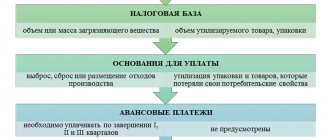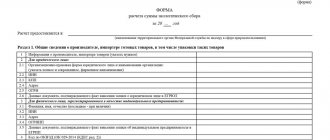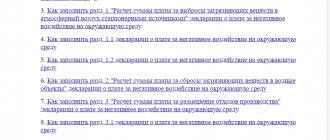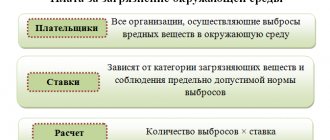Since January 10, 2002, the federal law “On Environmental Protection” has been in force in Russia, one of the clauses of which provides for a fee for negative environmental impact (NEI). Every year, enterprises and individual entrepreneurs in our country have many questions about the rules for filing a declaration, payment deadlines and possible penalties. This article will help you obtain comprehensive information on this issue and understand the procedure for filling out all the necessary documentation.
general information
The provisions on the tax for environmental pollution replaced the already outdated law on environmental pollution. This fee is defined by the Constitution as a mandatory public payment and is formally considered a fiscal fee. According to the Tax Code, such contributions are mandatory and do not exempt enterprises from taking environmental protection measures.
In accordance with the Federal Law of January 10, 2002 “On Environmental Protection,” the following types of environmental impact assessments are provided. This:
- pollution of surface and underground water bodies, discharge of pollutants into places where water is collected for the needs of the population;
- toxic emissions into the atmosphere, this applies to stationary objects;
- disposal of solid waste generated during the production process.
The terms and rates of payment are stipulated in the Decree of the Government of the Russian Federation dated September 13, 2016 No. 913.
Other types of harmful effects on the environment, such as soil pollution, excess noise, vibration or electromagnetic radiation, are not subject to tax, since there is no way to measure the degree of impact on nature, and therefore there is no standard for determining the required fee. Contributions for atmospheric emissions from mobile objects are also not made, as indicated by letters from the Russian Ministry of Natural Resources dated July 23, 2015 No. 02-12-44/17039 and dated March 10, 2015 No. 12-47/5413. So the organization does not have to pay for existing vehicles.
All issues related to payment and provision of reporting documentation are controlled by the Federal Service for Supervision of Natural Resources of the Russian Federation.
Registration with Rosprirodnadzor: questions and answers
State registration of objects that have a negative impact on the environment (NVOS objects) is carried out by Rosprirodnadzor by maintaining a state register (Article 14 of the Federal Law of July 27, 2006 N 149-FZ “On Information, Information Technologies and Information Protection”, paragraph 3 Article 69 of the Federal Law of January 10, 2002 No. 7-FZ “On Environmental Protection”, clause 13 of the Rules for the creation and maintenance of the state register of objects that have a negative impact on the environment, approved by Decree of the Government of the Russian Federation of June 23, 2016 No. 572).
Registers of NVOS objects
The register is a government information system (GIS). It consists of:
- federal state register containing information about objects subject to federal state environmental supervision. The register is maintained by the territorial bodies of Rosprirodnadzor at the location of the NVOS facilities;
- regional state registers, which contain information about objects subject to regional state environmental supervision. Such registers are maintained by the executive authorities of the constituent entities of the Russian Federation at the location of the NVOS facilities.
What to register
Legal entities and individual entrepreneurs must register with the state exactly those NVOS facilities on which they carry out economic or other activities - directly use (operate). Cases of direct use include the placement of waste produced by oneself or waste received from third-party organizations for placement on one’s own territory.
If the property is leased, the tenant must register it. If an NEE facility includes several sources of negative impact (including sources of emissions, discharges, waste disposal sites), then in order to be registered it must satisfy the requirement of territorial connectivity.
The object does not harm nature
The following do not apply to the objects of the NVOS:
- land;
- individual pieces of equipment available on the organization’s balance sheet. They cannot be independent objects of the NVOS;
- objects that do not meet the Criteria for classifying objects that have a negative impact on the environment as objects of categories I, II, III and IV, approved by Decree of the Government of the Russian Federation dated September 28, 2015 No. 1029 (hereinafter referred to as the Criteria). This is, for example, a facility where waste is generated, but there are no other types of negative impact specified in the Criteria. Or an object where there are no stationary sources of emissions of pollutants into the environment, there are no discharges of pollutants into the water disposal systems as a result of the use of water for purposes other than domestic needs, and the types of activities specified in paragraphs 1 - 4, 7, 8 of the Criteria are not carried out .
Wrong category of object NVOS
All NEI objects are divided into four categories (I to IV) based on the Criteria. The category of an object is determined when it is registered with the state and can be changed at the stage of consideration of the application.
If the territorial body of Rosprirodnadzor, when considering the application, considers that the NVOS facility does not correspond to the declared category, then it will enter into the register and into the certificate the category that corresponds to the economic activity at the facility and the level of negative impact.
The territorial body of Rosprirodnadzor must notify the organization or entrepreneur that the NVOS facility it operates has been assigned a category different from the one that was declared by it, indicating the points of the Criteria on the basis of which such a decision was made.
Wrong registry
If, when considering an application, the territorial body of Rosprirodnadzor or the executive body of the constituent entities of the Russian Federation determines that the object should be included in the register of a different level (federal or regional), then:
- the application will be forwarded electronically to its destination using GIS tools within 5 working days from the date of registration;
- the person who submitted the application will be notified of its forwarding.
How to fill out an application
To indicate in the application actual data on emissions (except for radioactive pollutants), discharges, and waste, you must use:
- statistical reporting forms No. 2-TP (air), No. 2-TP (water management) and No. 2-TP (waste);
- production environmental control data;
- information from reporting on fees for negative environmental impact.
Sections of the application relating to information about waste are not filled out if the organization or entrepreneur does not place waste at the operating NWOS facilities (in the corresponding lines of the application an entry is made: “Waste disposal activities are not carried out”).
In paragraph 5 of section 4 of the application, when submitting information “on monitoring the condition and pollution of the environment on the territory of waste disposal sites and within the limits of their impact on the environment,” it is advisable to indicate data on the approval of a program for monitoring the condition and pollution of the environment on the territory of the waste disposal site and within the limits of its impact on the environment (date, number of the order approving the program, if there is such an order).
If there are only such objects as:
- waste disposal facilities decommissioned (including reclaimed or mothballed);
- waste disposal facilities located in territories the use of which for waste disposal is prohibited by the legislation of the Russian Federation;
- special radioactive waste disposal facilities;
- cattle burial grounds;
- medical waste disposal facilities
data about the program is not indicated in the application and in paragraph 5 of section 4 of the application an entry is made: “The program is not available due to the presence of waste facilities that comply with clause 3 of the Procedure for the owners of waste disposal facilities, as well as persons in whose possession or use the facilities are located waste disposal, monitoring the condition and pollution of the environment in the territories of waste disposal sites and within the limits of their impact on the environment, approved by Order of the Ministry of Natural Resources of Russia dated March 4, 2016 N 66.”
How to indicate the coordinates of the corner points of an object is described in paragraph 2.6 of the commented Notification.
How to indicate the best available technology is explained in paragraph 2.7 of the commented Notice.
Who is applying
Legal entities and individual entrepreneurs must register with the state exactly those NVOS facilities at which they carry out economic and (or) other activities.
To make a decision on a legal entity, individual entrepreneur, which is obliged to register the NVOS facility with the state, it is necessary, among other things, to be guided by the information registered in the Unified State Register and contained in the licenses issued to conduct activities at the NVOS facility.
How to apply
The application is submitted at the location of the facility - to the territorial body of Rosprirodnadzor or the authorized executive body of the constituent entity of the Russian Federation. The central office of Rosprirodnadzor does not accept applications.
If an organization or entrepreneur operates in two or more production areas that are distant from each other at a considerable distance and are not connected by pipelines, railways or otherwise (technically), it is necessary to register two or more production facilities with the submission of an application for each facility.
Updating information about the NVOS object
Data in the register about NEVOS objects is subject to updating when an organization or entrepreneur provides the following information.
1. On the replacement of the person conducting activities at the NVOS facility; on the reorganization of a legal entity in the form of transformation, on changing its name, address (location); on changing the last name, first name, patronymic (if any), place of residence of an individual entrepreneur, details of his identity document.
2. On changing the location of the NVOS object.
The above information must be submitted to the relevant territorial body of Rosprirodnadzor or the executive body of a constituent entity of the Russian Federation no later than 30 days from the date of state registration of such changes.
3. On changes in the characteristics of technological processes of main industries, sources of environmental pollution.
4. On changes in the characteristics of technical means for the neutralization of emissions, discharges of pollutants, technologies for the use, neutralization and disposal of production and consumption waste.
What is punishable
Failure to fulfill or untimely fulfillment of the obligation to submit an application for state registration of NVOS objects entails the imposition of an administrative fine (Article 8.46 of the Code of Administrative Offenses of the Russian Federation):
- for officials - in the amount of 5,000 to 20,000 rubles;
- for legal entities - from 30,000 to 100,000 rubles.
Who is the payer?
NVOS is one of the measures of state control over the level of environmental pollution. According to the Federal Law of January 10, 2002, the established fee must be paid by all organizations, enterprises and institutions whose activities are associated with a negative impact on nature. This list includes domestic and foreign companies, as well as legal entities and individuals. Since 2010, fees for NVOS have also been charged to budgetary organizations that were previously exempt from this responsibility.
Many resource users have questions about the conditions under which an enterprise can be exempt from these contributions. The fee is not transferred only if the production facilities have a hazard category of IV, which means:
- no radioactive emissions are produced;
- the amount of harmful emissions does not exceed ten tons per year;
- The company's activities do not affect the pollution of surface and groundwater.
The degree of danger of an object is determined by Rosprirodnadzor after conducting an appropriate inspection.
Some managers are mistaken that concluding an agreement with an organization engaged in the removal and disposal of waste exempts them from paying tax on the NVOS. The owner (if it is not an office, school, small enterprise, etc.) is in any case obliged to make annual contributions for the negative impact on the environment.
How to determine whether an NVOS object belongs to category IV
Let us remind you that, according to the degree of harm, objects that have a negative impact on the environment are divided into four categories:
- Category I objects - have a significant negative impact on the environment and belong to the areas of application of the best available technologies;
- objects of category II - have a moderate negative impact on the environment;
- objects of category III - have an insignificant negative impact on the environment;
- objects of category IV - have minimal negative impact on the environment.
All legal entities and individual entrepreneurs operating at facilities of categories I-III are required to pay a fee for the negative impact on the environment. And those who work exclusively at category IV facilities are exempt from paying environmental fees (Clause 1, Article 16.1 of the Federal Law of January 10, 2002 No. 7-FZ “On Environmental Protection”; see “Rosprirodnadzor has revised its position: offices are not needed register with the state in order to receive exemption from environmental payments").
Buy the “Ecologist Module” service for preparing and sending reports to the RPN
According to the Decree of the Government of the Russian Federation dated September 28, 2015 No. 1029, objects of category IV are considered objects where two conditions are simultaneously met:
- the presence at the site of stationary sources of environmental pollution, the mass of pollutants in emissions into the atmospheric air of which does not exceed 10 tons per year, in the absence of substances of hazard classes I and II, radioactive substances in the emissions;
- the absence of discharges of pollutants in wastewater into centralized drainage systems, other structures and systems for the disposal and treatment of wastewater, with the exception of discharges of pollutants resulting from the use of water for domestic needs, as well as the absence of discharges of pollutants into the environment.
The question arises: how to determine the hazard class of pollutants? Rosprirodnadzor in a letter dated April 26, 2017 No. AS-09-01-36/8824. answers it this way: in order to determine the hazard class of pollutants, it is necessary to use hygienic standards for atmospheric air quality, which provide hazard classes for pollutants. Such standards, in particular, include “Maximum permissible concentrations (MPC) of pollutants in the atmospheric air of populated areas (GN 2.1.6.3492-17)”, approved by Resolution of the Chief State Sanitary Doctor of the Russian Federation dated December 22, 2017 No. 165.
Categories of NVOS sources
When delimiting NVOS objects, a number of criteria are taken into account that determine the level of impact of production on nature. The main provisions are stated in Federal Law No. 7 of January 10, 2002, but in 2014 a special commission made significant changes and additions.
According to these regulations, the following conditions are taken into account to classify an enterprise as a certain category:
- level of harmful impact on the environment;
- to what class the industrial facility or production belongs, to what industry;
- hazard class of discharged substances, toxicity level, presence of mutagenic properties in waste;
- classification as a nuclear energy facility.
According to the specified criteria, NEO facilities are divided into four categories, where I means that the source of pollution has a serious impact on the environment, II – moderate NEO, III – insignificant; and IV is the minimum.
Federal Law No. 219 of July 21, 2014 introduced significant changes to the rules for classifying an enterprise into a particular group. For example, research centers, design bureaus, etc. were removed from the Category I list.
Categories of objects NVOS
On the basis of environmental legislation, all enterprises had to register, by December 31, 2016, with state registration of facilities that have a negative impact on the environment, which, depending on the measure of environmental impact, are assigned the following categories of environmental impact:
- objects of category 1 (providing a significant NVOS and related to the areas of application of the best available technologies, hereinafter referred to as BAT);
- objects of category 2 (providing moderate NVOS);
- objects of the 3rd category (providing insignificant NVOS);
- Category 4 objects (providing minimal environmental impact).
Objects of environmental accounting, how to find out the NVOS category?
NVOS objects include capital construction objects with a general purpose, connected physically or technologically.
Based on clause 4 of Art. 4.2 of Federal Law No. 7-FZ, the assignment of a category to an object is carried out when it is registered with the state.
In order to find out the NVOS category you need to:
- within 6 months from the date of commencement of operation of the facilities, submit to Rosprirodnadzor an application approved by the federal executive body authorized by the Government of the Russian Federation.
The responsible executive authority, within 10 days from the date of receipt of the application, carries out state registration by assigning a code and category to the object and providing a certificate of state registration of this object.
Criteria for determining the category of objects NEI:
- level of environmental impact of activities (industry, part of the industry, production);
- level of toxicity, carcinogenic and mutagenic properties of pollutants in emissions, discharges and hazard classes of production and consumption waste;
- classification of industrial facilities and production;
- carrying out activities in the field of atomic energy use.
The register of NVO facilities can be found on the website of the Federal Service for Supervision of Natural Resources.
Objects of 1st category NVOS
Category I includes objects that relate to the areas of application of BAT (best available technologies), which is reflected in Federal Law No. 7-FZ “On Environmental Protection”. To be assigned to category I, approved by Order of the Government of the Russian Federation dated December 24, 2014 No. 2674-r, it is necessary to carry out:
- Equipping pollution sources with automatic emission measurement systems, as specified in clause 9 of Article 67 of Federal Law No. 7-FZ “On Environmental Protection”.
- Develop technological standards and approve a program of industrial environmental control (the procedure for industrial environmental control), in accordance with paragraph 2 of Article 67 of Federal Law No. 7-FZ “On Environmental Protection”, and also obtain an Integrated Environmental Permit (IEP).
Objects of category 2 NVOS
From 01/01/2019, for this category of enterprises it is necessary to develop an environmental impact declaration, which includes the calculation of emission and discharge standards, limits on waste disposal, and an industrial environmental control program (IEC). The declaration is submitted once every 7 years, provided there are no changes in the operating technology of the enterprise.
Objects of category 3 NVOS
Category III includes objects that have little impact on the environment. Such enterprises must submit Reports on the generation, use, neutralization and disposal of waste (clause 5 of Article 18 of Federal Law No. 89-FZ “On Production and Consumption Waste”, entered into force on January 1, 2019), and also submit Reports on emissions of harmful (pollutant) substances into the atmospheric air (according to clause 11 of Article 15 No. 96-FZ “On the Protection of Atmospheric Air”). These organizations develop and approve independently the PEC (environmental control program) in accordance with the requirements of Federal Law No. 7-FZ. Based on the PEC program, a report on the results of industrial environmental control is being developed.
Objects of category 4 NVOS
Based on Article 67 of Law No. 7-FZ, category IV facilities do not need to develop an industrial environmental control program. From January 1, 2021 (clause 5 of Article 22 of Law No. 219-FZ), the calculation of permissible discharge standards has been cancelled. Also, from January 1, 2021, the development of PNOLR and submission of reports on waste management are canceled (clause 2 of article 3 of Law No. 219-FZ). Category IV objects are exempt from submitting an environmental impact declaration (Clause 8, Article 31.2 of Law No. 219-FZ).
What applies to NVOS objects?
According to the definition prescribed in Federal Law No. 7 of January 10, 2002, environmental pollution facilities are a source (or a combination of them) of harmful effects on the environment located in a separate territory.
Depending on the nature of the location, the following types of objects are distinguished:
- Stationary ones are industrial pipes, boiler rooms, parking lots, diesel installations, places where metal, wood are processed, paint is processed, wastewater treatment plants are located, etc.
- Mobile – any enterprise vehicles, including air, water and underwater, all those whose engines run on gasoline, diesel, gas or kerosene.
- Wastewater discharges are any sources that generate contaminated water as a result of industrial activities and discharge it onto the ground, into a river, lake or sea.
- Household and industrial waste generated during the operation of the enterprise.
The last point includes many public places, such as administrative buildings, schools, workshops, offices, shops, etc.
What is not the subject of the NVOS
Even if certain institutions are not registered, environmental requirements are also applied to them in a lesser form compared to others. Categories that can be united by common characteristics are not registered:
- There are no “household” emissions;
- There are no stationary sources of emissions that pollute the environment or air.
Organizations of economic activity serve as such an example. These can be administrative, educational, social, non-profit, trade union institutions. They also include gardening partnerships.
Registration
The registration of an organization in the state accounting system is carried out by the territorial Rosprirodnadzor. The tax assessment of the object and the established tax amount will be determined by the regulatory authority itself. The only thing the organization needs to do is fill out an electronic application on the free service of Rosprirodnadzor.
The easiest way to do this is with a certified electronic signature. Together with the application, this data is uploaded to the portal, and all that remains is to wait for confirmation from the territorial authority. If there is no electronic signature, the application is generated using the module where the latest version of the NVOS form is located. The completed document is printed and sent to the controlling organization by mail.
Rosprirodnadzor will register the application, assign it an account number and enter into the register all the data about the source of the NVOS. This is primarily beneficial for enterprises, since if non-payment of special contributions or the fact of concealing the real level of damage to nature is revealed, the organization faces a serious fine.
When do you need to pay?
In paragraph 5 of Art. 16.4 Federal Law No. 7 of January 10, 2002 states that all deductions for negative impacts on the environment must be made once a year (previously once a quarter) no later than the first of March of the year following the reporting year. In 2021, changes were made for large industrial enterprises; it became possible to make an advance payment no later than the 20th; its amount is ¼ of the fee transferred for the previous year. Individual entrepreneurs and small businesses are not affected by this innovation; they pay tax once a year.
Since 2021, the reporting procedure has changed; now the company must draw up a special document in a form approved by the Government of the Russian Federation. The NEI declaration includes several sections; you only need to fill out those that are necessary for the organization. The company must itself calculate the amount of payments, taking into account all possible pollution associated with production. If, for example, the enterprise does not have stationary sources of hazardous waste emissions, then nothing needs to be entered in the first section of the NVOS payment form.
When do you need to register for an NVOS?
There are certain categories of NVOS object developed by the government authorities of the Russian Federation. The criteria for registering NVES facilities are emissions of substances and their quantities, and the use of water for industrial or domestic needs. List of criteria for classifying objects as NEI:
- Little harm to the environment along with the use of the best available technologies.
- Moderate action.
- Minor impact.
- Negative impact on the environment.
The classification of NEI objects into a category is subject to change if data adjustments occur.
Enterprises of the first three categories must maintain industrial environmental control PEC, that is, strictly record emissions (discharges), and submit reports.
How to find out the required amount?
Every year, new rates and tariffs are calculated, on the basis of which the fee for the NVOS is set. Today, the amount of deductions is prescribed in Decree of the Government of the Russian Federation dated September 13, 2016 No. 913, the data is valid until 2021.
Letter dated June 4, 2007 No. 04-09/673 of the Federal Service for Environmental Supervision contains detailed information on how the NVOS is calculated, as well as on additional coefficients and rates.
You can calculate the final payment amount through the Eco-Expert program, which allows you to optimize the management of the enterprise’s activities and automate the calculations of taxes on the NVOS. There are other programs, including the “NVOS Module,” specially created to simplify the reporting process for organizations, as well as optimize the work of regulatory authorities. You can find it on the official website of Rosprirodnadzor.
When making final calculations, some enterprises are required to take into account an additional coefficient if their economic activities take place in territories specially protected by the state.
Declaration submission format
According to the established rules, a report for a certain period must be submitted electronically; the date of submission will be considered the moment of its registration on the Rosprirodnadzor website. In some cases, filling out the NVOS declaration is allowed on paper:
- if the nature user does not have an electronic signature;
- provided that the annual payment does not exceed 25 thousand rubles;
- or the payer does not have access to the Internet.
In such cases, the deadline for acceptance of payment will be considered the moment of submission to the regulatory authorities.
Filling rules
The NVOS declaration form was approved by order of the Russian Ministry of Natural Resources on January 09, 2017. It contains comments and notes describing the procedure. In addition, there are some nuances that must be taken into account by the person responsible for filling it out.
- In the existing table, only those sections that directly relate to the economic activities of the organization are filled in.
- If a company has facilities in different regions of the country, each of them draws up its own IEE declaration.
- All amounts are written with an accuracy of one hundredth; rounding can only be done in accordance with existing rules.
- All numbers, with the exception of TIN and KPP, are entered in the cells from right to left, starting with the smallest.
- All sheets must be signed by the person responsible for filling out the NVOS.
Finished documents, bound, numbered, with the seal of the organization and the signature of the head, are submitted to the territorial Office of Rosprirodnadzor. No additional papers are usually required, but in some cases regulatory authorities ask to provide a lease agreement, regulatory documents, waste transfer acts, etc.
Form and content of the application for assignment of the NVOS category
Before registering an object with Rosprirodnadzor, you must fill out an application. The form was approved by order of the Ministry of Natural Resources No. 554 dated December 23, 2015. The document states:
- details and basic information about the applicant (TIN, name, etc.);
- information about the object (location, type of activity, use of technology);
- level of negative impact from work (sources, their quantity, physical volume and characteristics of the impact);
- data from those with permits and completed environmental management procedures described in the legislation (various expert opinions, permits and limits, registration and submitted declarations);
- list of activities aimed at protecting the natural environment.
As a rule, all data for the application is available in the statutory documents (issued permits) of the applicant enterprise.
Submission of an application for inclusion in the register of NVOS facilities must occur no later than 6 months from the date of commencement of operation.
Sample
Filling out the NVOS declaration is a rather labor-intensive task that requires employees to have certain knowledge and skills. Today there are special companies that provide such a service. In small companies, this responsibility falls on the shoulders of accountants, since not everyone can afford the position of environmentalist. Today there are special companies that provide such a service. However, there are basic principles that will help you figure out what items the form of payment for the NVOS consists of.
1. Title page: all information about the organization and founders is indicated here:
- Name;
- Full name of the head;
- Contact details;
- TIN and checkpoint;
- organizational and legal form;
- signatures of the manager and accountant.
2. Section 1: data on stationary sources is recorded here, the category of the facility, its name, code and location, as well as the date and number of the issued permit for emissions are indicated.
3. Section 1.1: In addition to the above information, indicators such as calculation methods for associated petroleum gas flaring, production and flaring volumes, process losses and utilization levels are added.
4. Section 1.2: this contains data on payment for harmful emissions into the atmosphere when burning or dispersing APG in volumes exceeding the established norm. The name of the object, location, code, calculation methods and data on production and use are also indicated.
5. Section 2: to be completed by the person responsible for the discharge of waste into wastewater and drainage waters.
6. Section 3: any waste that has a negative impact on the environment (garbage, municipal solid waste, etc.) is indicated here.
7. Section 3.1: All activities involving disposal or disposal of waste are specified.
A specific example of filling out the NVOS can be found in the appendix to the Order of the Ministry of Natural Resources of Russia dated 01/09/2017 No. 3 “On approval of the Procedure for submitting a declaration on payment for negative impact on the environment and its forms.”
Small business representatives often have questions about point No. 3. If they prove that the organization is not involved in harmful emissions, it will be necessary to contact the territorial body of Rosprirodnadzor to remove the company from the list of payers.
What is the “Nature User Module”?
Since 2011, Russia has been actively implementing a program to transfer government services into electronic form. Every year more and more departments and structures join the initiative. Since 2012, the Federal Service for Environmental Management has been accepting all reports containing information on waste disposal, as well as on payment of fees for negative environmental impact, mainly in electronic form.
“NVOS Module” is a free program created specifically for the needs of natural resource users. Here, the head of the company or other responsible person can maintain an information base about the volume of negative impact on the environment and include details of the posting documents. The module also allows you to calculate fees for the tax assessment.
The program provides the following reports:
- Calculation of the payment amount.
- 2-TP (Waste).
- Application for registration of an object in the Rosprirodnadzor system.
- For small and medium-sized businesses, reporting on the generation, use and storage of waste is provided.
Information about the organization and available documents will need to be entered only once, then, as necessary, add data on the economic activities of the enterprise. All reports are generated by the program.
Consequences of non-payment
Many users of natural resources are interested in the question of where the paid funds go. Since the contribution for the negative impact on the environment is not considered a tax itself, but is a special form of compensation, the amount is distributed in a different way. Part of the amount goes to restore the nature of the region of the country where the economic activity is located. The federal budget receives 20% of the funds, the income of the constituent entities of the Russian Federation - 40% and municipal districts - also 40%.
The legislation provides for administrative liability for failure to make payment within the specified time frame. According to the Code of the Russian Federation of June 22, 2007 “On Administrative Violations,” a fine may be imposed for late payment: for an individual – 3,000–6,000 rubles, for legal entities – from 50,000 to 100,000 rubles.
FAQ
Small companies believe that their activities are not covered by the NVOS law, but this is not the case. All enterprises are required to pay contributions to Rosprirodnadzor. During office work, household waste is also generated: garbage, used lamps, computer equipment, paper, etc. But if a company has an agreement with a company involved in waste removal and disposal, then responsibility for harm to the environment passes to it . The same applies to tenants: they have the right not to pay environmental tax if the contract stipulates that payments are made by the owner of the premises.
If the company did not carry out any activities during the reporting period, then the management will need to submit the so-called zero calculation. However, if regulatory authorities discover fraud, a fine will be imposed on the company in accordance with the Code of Administrative Offenses.
The organization is obliged to keep records in the field of waste management. In case of an audit, there must be a special journal; it can be in paper or electronic form. For this purpose, special programs are provided, including the NVOS module. This application can be found on the official website of Rosprirodnadzor. The data storage period is five years. Also, managers must have passports for all waste generated at the enterprise.
Currently, the legislation does not establish a procedure for returning funds in case of overpayment. In this case, you must contact the territorial body of Rosprirodnadzor with all the papers confirming the transfer of funds and a declaration for the NVOS. The organization will reconcile the data, and if the overpayment is confirmed, the funds will be returned.
The procedure for assigning the NVOS category
The procedure for registering with Rosprirodnadzor involves a government employee checking the contents of the application. After reviewing the application, a certificate of registration is generated. The certificate contains the category and code of the object. This unique number is retained until the object is liquidated. In addition, the certificate contains the name, INN, OGRN, OKNPO, location address, type and date of commencement of operation.
So, the procedure for registering an object with Rosprirodnadzor involves determining the category and filling out an application. This is a mandatory procedure, and thus the damage to the environment is compensated.
If you need registration with Rosprirodnadzor, please contact the specialists of our company.





